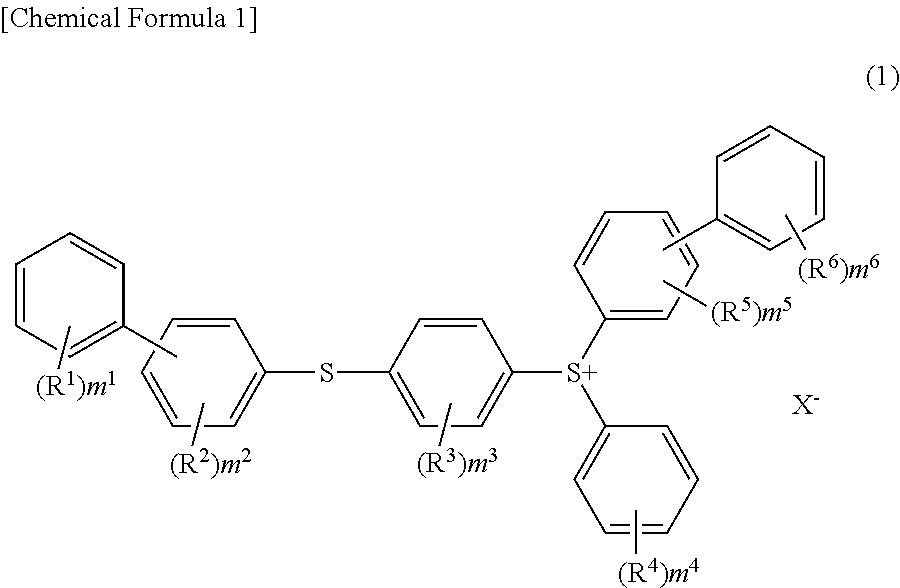Sulfonium salt, photo-acid generator, and photosensitive resin composition
a technology of photoacid generator and sulfonium salt, which is applied in the direction of photosensitive materials, instruments, group 3/13 element organic compounds, etc., can solve the problems of low sensitivity to the i-line (365 nm), low storage stability of resist composition, and failure to cure, etc., to achieve excellent photosensitivity, excellent storage stability, and high compatibility
- Summary
- Abstract
- Description
- Claims
- Application Information
AI Technical Summary
Benefits of technology
Problems solved by technology
Method used
Image
Examples
production example 1
Synthesis of 4-(phenylthio)biphenyl
[0292]Uniformly mixed were 3.0 parts of 4-bromobiphenyl, 1.7 parts of thiophenol, 2.5 parts of sodium tert-butoxide, 0.15 parts of tetrakis(triphenylphosphine)palladium, and 64.3 parts of 1-butanol, and allowed to react at 120° C. for 2 hours. The reaction solution was cooled to room temperature (about 25° C.) and then filtered. The filtrate was transferred to a rotary evaporator, and the solvent was removed by distillation, so that a red-brown, crystalline product was obtained. The product was dissolved in 70 parts of dichloromethane, and 50 parts of an aqueous saturated sodium hydrogen carbonate solution was added thereto. After washing three times by liquid-liquid separation, the dichloromethane layer was washed with 70 parts of distilled water until the pH became neutral. The dichloromethane layer was transferred to a rotary evaporator, and the solvent was removed by distillation, so that a brown, crystalline product was obtained. Twenty parts ...
production example 2
Synthesis of a Mixture Containing 4-[(phenyl)sulfinyl]biphenyl and 4-(phenylthio)biphenyl
[0293]Uniformly mixed were 2.0 parts of 4-(phenylthio) biphenyl synthesized in Production Example 1, 8.0 parts of acetonitrile, 0.037 parts of sulfuric acid, and 0.43 parts of an aqueous 30% hydrogen peroxide solution, and allowed to react at 65° C. for 3 hours. After the reaction solution was cooled to room temperature (about 25° C.), 30 parts of dichloromethane was added, and washing by liquid-liquid separation was performed with 40 parts of distilled water until the pH became neutral. The dichloromethane layer was transferred to a rotary evaporator, and the solvent was removed by distillation, so that a brown liquid mixture containing 55% of 4-[(phenyl)sulfinyl]biphenyl and 45% of 4-(phenylthio)biphenyl. The product was isolated by column chromatography (eluent: ethyl acetate / hexane=1 / 1 in volume ratio) and then identified by 1H-NMR. The 1H-NMR data for 4-[(phenyl)sulfinyl]biphenyl: {d6-dimet...
production example 3
Synthesis of 4-[(2-methylphenyl)thio]biphenyl
[0294]Brown crystalline 4-[(2-methylphenyl)thio]biphenyl was obtained in a yield of 89% as in Production Example 1, except that “1.7 parts of thiophenol” was replaced with “1.8 parts of 2-methylthiophenol”. The product was identified by 1H-NMR {d6-dimethylsulfoxide, δ (ppm) 7.6-7.7 (4H, m), 7.3-7.5 (9H, m), 2.3 (3H, s)}.
PUM
| Property | Measurement | Unit |
|---|---|---|
| wavelength | aaaaa | aaaaa |
| emission wavelength | aaaaa | aaaaa |
| thickness | aaaaa | aaaaa |
Abstract
Description
Claims
Application Information
 Login to View More
Login to View More - R&D
- Intellectual Property
- Life Sciences
- Materials
- Tech Scout
- Unparalleled Data Quality
- Higher Quality Content
- 60% Fewer Hallucinations
Browse by: Latest US Patents, China's latest patents, Technical Efficacy Thesaurus, Application Domain, Technology Topic, Popular Technical Reports.
© 2025 PatSnap. All rights reserved.Legal|Privacy policy|Modern Slavery Act Transparency Statement|Sitemap|About US| Contact US: help@patsnap.com



